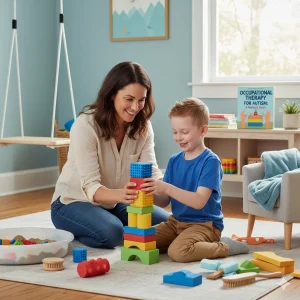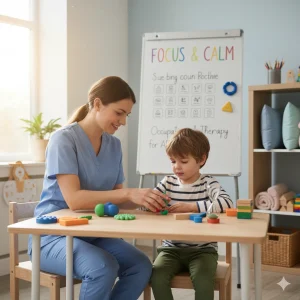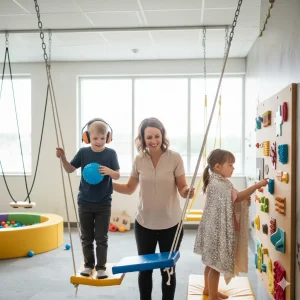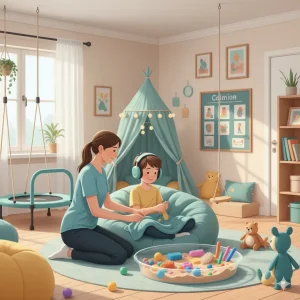Do Social Stories Help Children with Autism – A Complete Guide
By Wellness Hub
Last Updated: January 22, 2025
Autism spectrum disorder presents unique communication challenges, often making social interactions overwhelming for those affected. Social stories are a therapeutic tool designed to help individuals with autism understand and navigate these interactions by outlining social norms and expected behaviors in relatable scenarios. At Wellness Hub, we provide resources to support the effective use of social stories, aiming to enhance understanding and ease communication for individuals on the autism spectrum. Join us in exploring the impactful role of social stories in autism therapy.
Social Stories for Autism
Explore how social stories can support children with autism and ADHD. Learn more about their impact and how to use them effectively.
Download NowWhat Are Social Stories?
Social stories are a valuable educational tool specifically designed for individuals with autism spectrum disorder (ASD). These short, structured narratives are crafted to explain social situations, delineating appropriate responses and expected behaviors through straightforward and easily digestible language. The primary goal of social stories is to enhance the social understanding of individuals with autism, helping them navigate complex interactions more effectively.
Key Elements of Effective Social Stories
For social stories to be truly effective, they must adhere to several foundational principles:
- Clear and Concise Language: Each story uses simple sentences that clearly convey the message without ambiguity.
- Descriptive and Directive Sentences: Stories combine descriptive sentences, which detail the setting and emotions, with directive sentences that gently guide the reader’s actions.
- Positive Tone: Social stories focus on positive outcomes and behaviors, reinforcing what the individual should do rather than what they shouldn’t.
- Customization: Tailoring stories to meet the specific needs and understanding of the individual ensures they are more relatable and impactful.
The Effectiveness of Social Stories in Autism Therapy
Social stories are an invaluable tool in autism therapy, helping individuals grasp and navigate complex social interactions and improve communication skills.
Improving Social Understanding
- Social Cues and Behaviors: Social stories simplify social cues, making it easier for children with autism to understand what is expected in various situations. For example, explaining the steps at a birthday party helps clarify greetings, gift-giving, and appropriate reactions to activities.
- Reduces Anxiety: By outlining expected behaviors, social stories can decrease the anxiety associated with new or complex social situations.
Enhancing Communication Skills
- Dialogue and Gestures: These stories provide examples of verbal and non-verbal communication. They teach polite phrases and show how to use body language, like nodding or maintaining eye contact.
- Builds Confidence: Regular use of social stories can help improve confidence in social interactions, making conversations less daunting.
Case Studies and Success Stories
- Example 1: A boy who had difficulties with school transitions learned to manage changes between activities smoothly through a custom social story, reducing his stress and disruptive behaviors.
- Example 2: A girl improved her conversational skills by using a social story focused on taking turns talking, which enhanced her ability to interact with peers.
Examples of Social Stories and Their Benefits for Children with Autism
| Social Story Title | Target Scenario | Benefits |
|---|---|---|
| “Joining In at Playtime” | Playground interactions | Enhances sharing skills, reduces anxiety |
| “Asking for Help” | Classroom environment | Improves communication, fosters independence |
| “Going to the Dentist” | Doctor/Dentist visits | Reduces fear, prepares for medical visits |
| “Making New Friends” | Social gatherings | Boosts social interaction, builds confidence |
| “Handling a Change in Routine” | Unexpected changes | Helps adapt to new situations, reduces meltdowns |
Unlock the Power of Social Stories
Social stories provide a structured way to help children with autism understand and navigate social interactions. Explore their benefits today!.
Learn MoreSocial Stories for Autism
Creating Effective Social Stories for Autism
Crafting effective social stories can make a significant difference in therapy for individuals with autism. These stories not only educate but also empower, providing clear and accessible insights into the nuances of social interaction. Here’s how to develop social stories that resonate and bring about real change.
Key Components of a Successful Social Story
Creating a social story that engages and educates requires several essential elements:
- Specificity: Tailor the story to address specific situations or challenges the individual faces, ensuring the content is directly applicable to their daily life.
- Simplicity: Use clear, simple language that is easy for the reader to understand. Avoid metaphors or ambiguous phrases that could confuse.
- Positivity: Focus on positive behavior outcomes and constructive actions the individual can take, rather than highlighting what they should avoid.
- Visuals: Incorporate images or simple illustrations that depict key actions or emotions to help convey the message more effectively.
- Consistency: Maintain a consistent format that includes a clear beginning, middle, and end to ensure the story is easy to follow.
Tips for Parents and Educators
Effectively integrating social stories into daily routines can enhance their utility and effectiveness:
- Routine Integration: Introduce social stories as a regular part of the day, perhaps during a morning routine or just before engaging in a challenging social scenario.
- Interactive Reading: Engage with the child while reading the story, asking questions and encouraging them to express their thoughts and feelings about the scenario.
- Repetition: Repetition is key in learning; revisit the same social story multiple times until the child appears comfortable with the concept and begins to apply the lessons learned.
- Feedback Incorporation: Observe the child’s responses to the stories and adapt them as needed to better meet their needs and address any new challenges that arise.
- Collaborative Story-Making: Involve the child in the creation of the stories. This can be a powerful way to ensure the content is meaningful to them and can help reinforce the lessons being taught.
Conclusion
Social stories are a key tool for helping individuals with autism understand social norms and improve communication. At Wellness Hub, we’re committed to providing effective resources that make implementing these stories easier for everyone involved. Our guides and expert advice can help you tailor social stories to meet unique needs, enhancing their impact. Explore our social story resources to learn more. For personalized support and more information, contact us today. Let’s work together to make every social interaction more manageable and meaningful for those with autism.
Frequently Asked Questions:
1. What are social stories for autism?
Social stories are short narratives designed to teach children with autism appropriate social behaviors by clearly explaining the cues and responses expected in various social situations.
2. How do social stories help children with autism?
They help by breaking down complex social interactions into manageable, understandable parts, allowing children to learn and rehearse social behaviors in a controlled setting.
3. Can social stories improve communication in autism?
Yes, social stories can significantly enhance both verbal and non-verbal communication by providing examples of appropriate interactions and responses.
4. Where can I find examples of social stories for autism?
You can find examples and templates on websites like Wellness Hub, which offers resources specifically designed for creating effective social stories.
5. How often should I use social stories with my child?
Regular use is recommended, especially before anticipated challenging social situations, to help your child familiarize themselves with expected behaviors.
6. Are social stories effective for non-verbal children with autism?
Absolutely! Social stories can help non-verbal children understand social expectations and interactions through pictures and simple, clear descriptions.
7. Can I create my own social stories for my child?
Yes, you can create personalized social stories tailored to your child’s specific needs and situations. Wellness Hub provides guidelines on how to craft effective stories.
8. What age group benefits most from social stories?
Children of all ages with autism can benefit, but they are especially effective for young children who are just learning to navigate social rules.
9. Do social stories work for all children with autism?
While social stories are beneficial for many, effectiveness can vary based on individual needs and cognitive abilities. It’s important to tailor stories to each child’s understanding.
10. How can I make a social story more engaging for my child?
Use colorful illustrations and keep the language simple. Relate the story to your child’s interests to capture their attention and make the learning experience enjoyable.
About the Author:
Shravanaveena Gajula
M.Sc ., Speech and Language Pathology (5+ years of experience)
Shravanaveena Gajula is a dedicated Audiologist and Speech-Language Pathologist with a BASLP and an M.Sc in Speech and Language Pathology. With experience spanning multiple settings, including Wellness Hub and Ashray Akruti, Veena specializes in a wide range of disorders from developmental issues in children to speech and language assessments in adults. Her expertise includes parent counseling, managing speech sound and fluency disorders, and creating individualized therapy programs. Veena is also PROMPT certified and an author of several insightful blogs on speech and language pathology, aiming to educate and assist caregivers in supporting their loved ones.
Book your Free Consultation Today
Parent/Caregiver Info:
Client’s Details:
* Error Message









